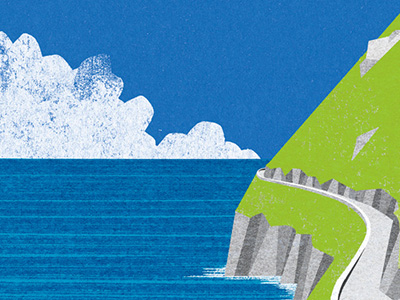|
The latest
research suggests Australia's Adam and Eve are not as old as we thought -
and lived much richer lives than we suspected. Deborah Smith reports.
Fifty thousand years ago, a lush landscape
greeted the first Australians making their way towards the south-east of
the continent. Temperatures were cooler than now. Megafauna - giant
prehistoric animals such as marsupial lions, goannas and the
rhinoceros-sized diprotodon - were abundant. And the freshwater lakes of
the Willandra district in western NSW were brimming with fish. But change
was coming. By the time the people living at Lake Mungo ceremoniously
buried two of their dead, 40,000 years ago, water levels had begun to drop.
A study of the sediments and graves at Lake
Mungo, published this week in Nature, uncovers the muddy layers
deposited as the lake began to dry up. Twenty thousand years ago Lake Mungo
had become the dry dusty hole we know today, but 20,000 years before that
it had been a refuge from the encroaching desert, the study shows. Families
clustered around the lake left artefacts, 775 of which researchers used to
determine that the number of people living there peaked between 43,000 and
44,000 years ago, with the first wanderers arriving between 46,000 and
50,000 years ago.
This treasure-trove of history was found by the
University of Melbourne geologist Professor Jim Bowler in 1969. He was
searching for ancient lakes and came across the charred remains of Mungo
Lady, who had been cremated. In 1974, he found a second complete skeleton,
Mungo Man, buried 300 metres away.
The comprehensive study of 25 different
sediment layers at Mungo - a collaboration between four universities, the
CSIRO, and NSW National Parks and Wildlife and led by Bowler - concludes
that both graves are 40,000 years old.
This is much younger than the 62,000 years
Mungo Man was attributed with in 1999 by a team led by Professor Alan
Thorne, of the Australian National University. Because Thorne is the
country's leading opponent of the Out of Africa theory - that modern humans
evolved in Africa about 100,000 years ago and then spread around the globe
- the revision of Mungo Man's age has refocused
attention on academic disputes about mankind's origins.
Dr Tim Flannery, a proponent of the
controversial theory that Australia's megafauna was wiped out 46,000 years
ago in a"blitzkrieg" of hunting by the arriving people, also
claims the new Mungo dates support this view.
For Bowler, however, these debates are
irritating speculative distractions from the study's main findings. At
40,000 years old, Mungo Man and Mungo Lady remain Australia's oldest human
burials and the earliest evidence on Earth of cultural sophistication, he
says. Modern humans had not even reached North America by this time. In
Europe, they were just starting to live alongside the Neanderthals.
"At Lake Mungo we have a cameo of people
reacting to environmental change. It is one of the great stories of the
peoples of the world."
THE modern day story of the science of Mungo
also has its fair share of rivalry. In its 1999 study, Thorne's team used
three techniques to date Mungo Man at 62,000 years old, and it stands by
its figure. It dated bone, teeth enamel and some sand.
Bowler has strongly challenged the results ever
since. Dating human bones is "notoriously unreliable", he says.
As well, the sand sample Thorne's group dated was taken hundreds of metres
from the burial site."You don't have to be a gravedigger ... to
realise the age of the sand is not the same as the age of the grave,"
says Bowler. He says his team's results are based on careful geological
field work that was crosschecked between four laboratories, while Thorne's
team was "locked in a laboratory in Canberra and virtually
misinterpreted the field evidence".
Thorne counters that Bowler's team used one
dating technique, while his used three. Best practice is to have at least
two methods produce the same result. A Thorne team member, Professor Rainer
Grun, says the fact that the latest results were consistent between
laboratories doesn't mean they are absolutely correct. "We now have two
data sets that are contradictory. I do not have a plausible
explanation."
Two years ago Thorne made world headlines with
a study of Mungo Man's DNA that he claimed supported his idea that modern
humans evolved from archaic humans in several places around the world,
rather than striding out of Africa a relatively short time ago.
Other scientists have expressed scepticism. But
Thorne's old age for Mungo Man was also regarded as evidence for his
theory. Homo sapiens would have had to move pretty fast to get from Africa
to NSW by 62,000 years ago.
Now, however, Thorne says the age of Mungo Man
is irrelevant to this origins debate. Recent fossils finds show modern
humans were in China 110,000 years ago. "So he has got a long time to
turn up in Australia. It doesn't matter if he is 40,000 or 60,000 years
old."
In 2001 a member of Bowler's team, Dr Richard
Roberts of Wollongong University, along with Flannery, director of the
South Australian Museum, published research on their blitzkreig theory.
They dated 28 sites across the continent, arguing their analysis showed the
megafauna died out suddenly 46,600 years ago.
The conclusion has been challenged by other
scientists, including Dr Judith Field of the University of Sydney and Dr
Richard Fullager of the Australian Museum, who point to the presence of
megafauna fossils at the 36,000-year-old Cuddie Springs site in NSW.
Flannery praises the Bowler team's research on
Mungo Man as"the most thorough and rigorous dating"of ancient
human remains. He says the finding that humans arrived at Lake Mungo
between 46,000 and 50,000 years ago supports the idea that 47,000 years ago
was a critical time in Australia's history. There is no evidence of a
dramatic climatic change then, he says. "It's my view that humans
arrived and extinction took place in almost the same geological
instant."
Bowler, however, is sceptical of Flannery's
theory and says the Mungo study provides no definitive new evidence to
support it. He argues that climate change at 40,000 years ago was more
intense than had been previously realised and could have played a role in
the megafauna's demise. "To blame the earliest Australians for their
complete extinction is drawing a long bow."
|












































